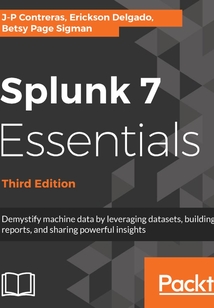舉報 

會員
Splunk 7 Essentials(Third Edition)
J P Contreras Erickson Delgado Betsy Page Sigman 著
更新時間:2021-08-27 19:38:20
開會員,本書免費讀 >
最新章節:
Summary
ThisbookisforthebeginnerswhowanttogetwellversedintheservicesofferedbySplunk7.Ifyouwanttobeadata/businessanalystorwanttobeasystemadministrator,thisbookiswhatyouwant.NopriorknowledgeofSplunkisrequired.
最新章節
- Summary
- The Splunk community and online resources
- Splunk pricing model
- Splunk Cloud
- Heavy forwarder
- Universal forwarder
品牌:中圖公司
上架時間:2021-08-27 18:14:15
出版社:Packt Publishing
本書數字版權由中圖公司提供,并由其授權上海閱文信息技術有限公司制作發行
- Summary 更新時間:2021-08-27 19:38:20
- The Splunk community and online resources
- Splunk pricing model
- Splunk Cloud
- Heavy forwarder
- Universal forwarder
- Forwarders
- Monitoring Console
- High availability for critical environments
- Indexing capacity and data replication
- Search capacity
- Splunk architecture for an organization
- Splunk architecture considerations
- Internet of Things
- Software development and support operations
- Cybersecurity
- IT operations
- Common organizational use cases
- Taking Splunk to the Organization
- Summary
- Using eval and match with a case function
- Using eval and if
- Using join
- Using append
- Subsearch
- Advanced searches
- Use the fields command to improve search performance
- Using event sampling
- Quick searches via fast mode
- Search within a limited time frame
- Searching within an index
- Indexes for testing
- Best Practices and Advanced Queries
- Summary
- Indexer acknowledgement
- Seeing the HEC in action with cURL
- Generating an HEC authentication token
- Enabling the HEC
- Indexing the data
- Verifying the token
- Sending out the data request
- Using a token with data
- Logging data
- How data flows to the HEC
- How does the HEC work?
- What is the HEC?
- HTTP Event Collector
- Summary
- Rearranging your dashboard
- Single value with trending sparkline
- Creating a pie chart
- Creating an area chart
- Creating a Pivot and a chart
- The Pivot editor
- Data model acceleration
- Creating an attribute based on a regular expression
- Creating child objects
- Adding attributes to objects
- Creating a data model
- Data Models and Pivot
- Summary
- Creating a choropleth map
- Real-time column charts with line overlays
- Single-value panels with trends
- Creating panels by cloning
- Single-value panels with color ranges
- Static real-time dashboard
- Creating a drop-down input
- Creating a radio input
- Creating a time range input
- Form inputs
- Column with overlay combination chart – Hits vs Response Time
- Stacked area chart – Status Types Over Time
- Pie chart – Status Distribution
- Panel options
- Arrange the dashboard
- Creating the Hits vs Response Time panel
- Creating the Status Types Over Time panel
- Creating a Status Distribution panel
- Dynamic form-based dashboard
- Gathering business requirements
- Types of dashboards
- Creating effective dashboards
- Dynamic Dashboarding
- Summary
- Summary indexing
- Scheduling options
- Search and Report acceleration
- Creating alerts
- Creating and scheduling reports
- Data enrichment with Lookups
- Data normalization with Tags
- Data classification with Event Types
- Reporting Alerts and Search Optimization
- Summary
- Search command – rex
- Search command – eval
- Search commands – chart and timechart
- Search command – top/rare
- Search command – stats
- Filtering search results
- Time modifiers
- Search pipeline
- Anatomy of a search
- Search Processing Language
- Summary
- Extracting new fields
- Splunk events and fields
- Log files as data input
- Buckets
- Creating indexes
- Other data types
- Relational database data
- Social media data
- Data files
- Web logs
- Machine data
- Splunk data sources
- Sparseness of data
- Analytical data latency
- Streaming data
- Splunk and big data
- Bringing in Data
- Summary
- Creating your first dashboard
- Viewing the Destinations app
- Configuring Eventgen
- Controlling Splunk
- Installing the Eventgen add-on (Windows and Linux)
- Using the CLI to configure Eventgen
- Populating data with Eventgen
- Creating a Splunk app
- Running a simple search
- Logging in for the first time
- Installing Splunk on Linux
- Installing Splunk on Windows
- Obtaining a Splunk account
- Your Splunk account
- Splunk – Getting Started
- Reviews
- Get in touch
- Conventions used
- Download the color images
- Download the example code files
- To get the most out of this book
- What this book covers
- Who this book is for
- Preface
- Packt is searching for authors like you
- About the reviewers
- About the authors
- Contributors
- PacktPub.com
- Why subscribe?
- Packt Upsell
- Splunk 7 Essentials Third Edition
- Copyright and Credits
- Title Page
- 封面
- 封面
- Title Page
- Copyright and Credits
- Splunk 7 Essentials Third Edition
- Packt Upsell
- Why subscribe?
- PacktPub.com
- Contributors
- About the authors
- About the reviewers
- Packt is searching for authors like you
- Preface
- Who this book is for
- What this book covers
- To get the most out of this book
- Download the example code files
- Download the color images
- Conventions used
- Get in touch
- Reviews
- Splunk – Getting Started
- Your Splunk account
- Obtaining a Splunk account
- Installing Splunk on Windows
- Installing Splunk on Linux
- Logging in for the first time
- Running a simple search
- Creating a Splunk app
- Populating data with Eventgen
- Using the CLI to configure Eventgen
- Installing the Eventgen add-on (Windows and Linux)
- Controlling Splunk
- Configuring Eventgen
- Viewing the Destinations app
- Creating your first dashboard
- Summary
- Bringing in Data
- Splunk and big data
- Streaming data
- Analytical data latency
- Sparseness of data
- Splunk data sources
- Machine data
- Web logs
- Data files
- Social media data
- Relational database data
- Other data types
- Creating indexes
- Buckets
- Log files as data input
- Splunk events and fields
- Extracting new fields
- Summary
- Search Processing Language
- Anatomy of a search
- Search pipeline
- Time modifiers
- Filtering search results
- Search command – stats
- Search command – top/rare
- Search commands – chart and timechart
- Search command – eval
- Search command – rex
- Summary
- Reporting Alerts and Search Optimization
- Data classification with Event Types
- Data normalization with Tags
- Data enrichment with Lookups
- Creating and scheduling reports
- Creating alerts
- Search and Report acceleration
- Scheduling options
- Summary indexing
- Summary
- Dynamic Dashboarding
- Creating effective dashboards
- Types of dashboards
- Gathering business requirements
- Dynamic form-based dashboard
- Creating a Status Distribution panel
- Creating the Status Types Over Time panel
- Creating the Hits vs Response Time panel
- Arrange the dashboard
- Panel options
- Pie chart – Status Distribution
- Stacked area chart – Status Types Over Time
- Column with overlay combination chart – Hits vs Response Time
- Form inputs
- Creating a time range input
- Creating a radio input
- Creating a drop-down input
- Static real-time dashboard
- Single-value panels with color ranges
- Creating panels by cloning
- Single-value panels with trends
- Real-time column charts with line overlays
- Creating a choropleth map
- Summary
- Data Models and Pivot
- Creating a data model
- Adding attributes to objects
- Creating child objects
- Creating an attribute based on a regular expression
- Data model acceleration
- The Pivot editor
- Creating a Pivot and a chart
- Creating an area chart
- Creating a pie chart
- Single value with trending sparkline
- Rearranging your dashboard
- Summary
- HTTP Event Collector
- What is the HEC?
- How does the HEC work?
- How data flows to the HEC
- Logging data
- Using a token with data
- Sending out the data request
- Verifying the token
- Indexing the data
- Enabling the HEC
- Generating an HEC authentication token
- Seeing the HEC in action with cURL
- Indexer acknowledgement
- Summary
- Best Practices and Advanced Queries
- Indexes for testing
- Searching within an index
- Search within a limited time frame
- Quick searches via fast mode
- Using event sampling
- Use the fields command to improve search performance
- Advanced searches
- Subsearch
- Using append
- Using join
- Using eval and if
- Using eval and match with a case function
- Summary
- Taking Splunk to the Organization
- Common organizational use cases
- IT operations
- Cybersecurity
- Software development and support operations
- Internet of Things
- Splunk architecture considerations
- Splunk architecture for an organization
- Search capacity
- Indexing capacity and data replication
- High availability for critical environments
- Monitoring Console
- Forwarders
- Universal forwarder
- Heavy forwarder
- Splunk Cloud
- Splunk pricing model
- The Splunk community and online resources
- Summary 更新時間:2021-08-27 19:38:20


